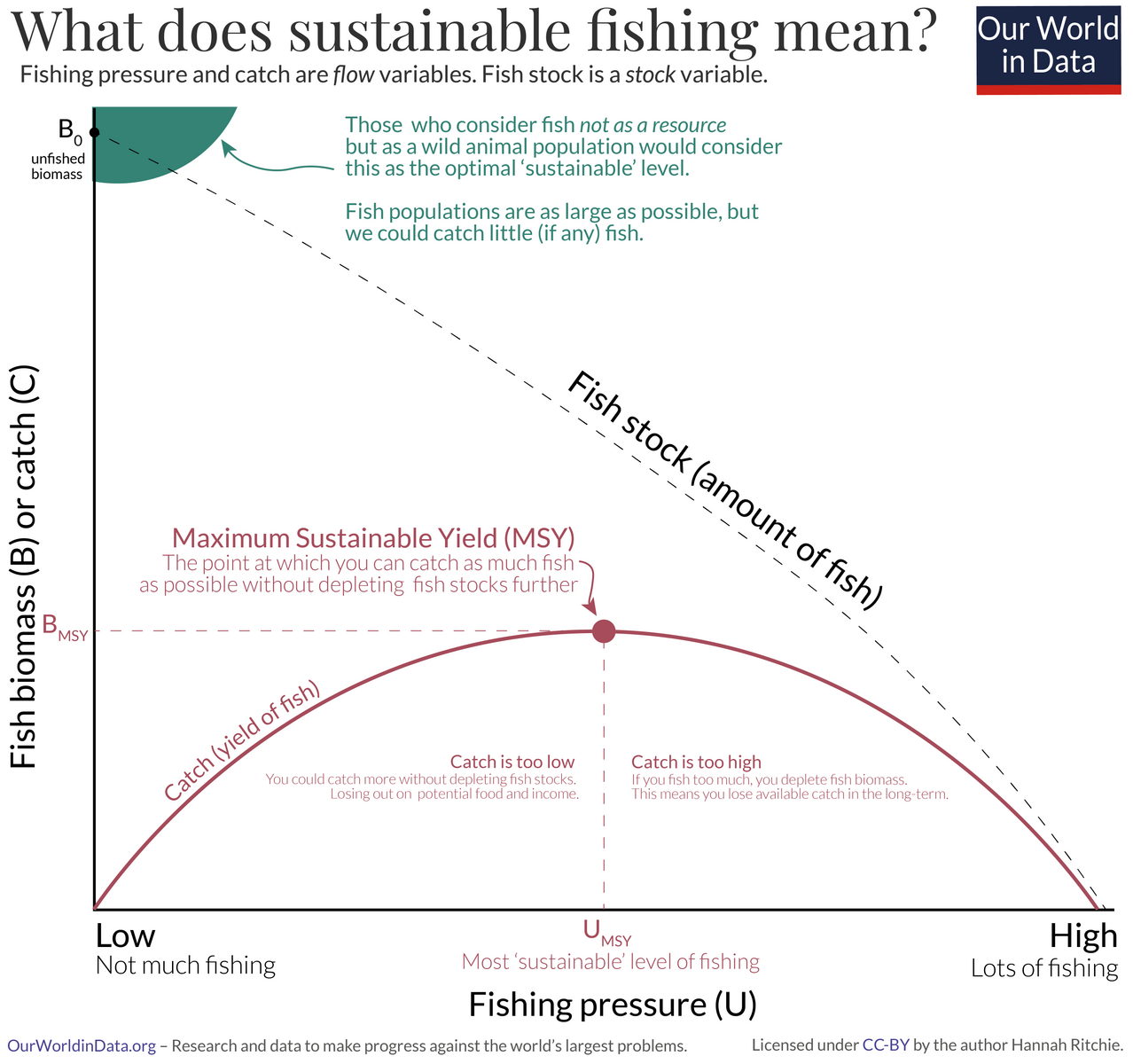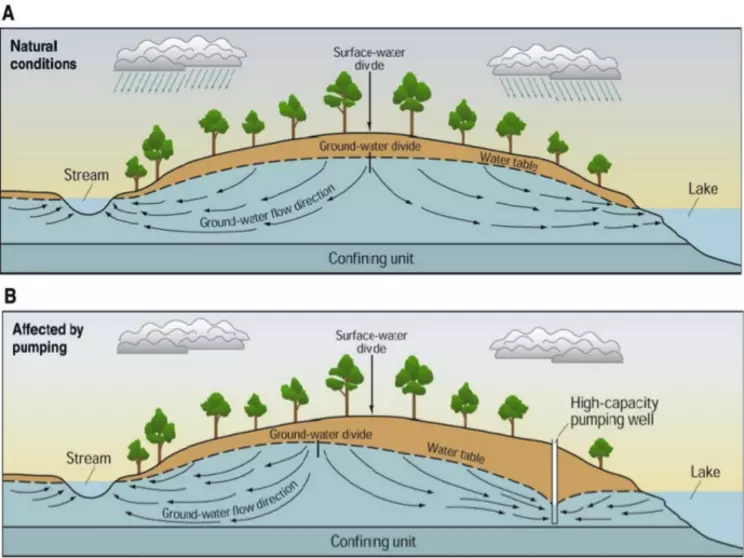IB Syllabus focus:
‘Resources are finite. Renewable stocks or processes must not be used faster than regeneration, or they effectively become non-renewable and unsustainable.’
Understanding the distinction between renewable and non-renewable resource use is central to sustainability. Managing consumption rates relative to regeneration ensures future availability and ecosystem balance.
Renewable vs Non-Renewable Resources
Renewable Resources
Renewable resources are natural materials or processes that can regenerate within a human timescale, provided their use does not exceed the rate of replenishment. Examples include:
Forests (regrow through natural succession or replanting)
Freshwater supplies (replenished by the hydrological cycle)
Fish stocks (renewable when harvested within reproductive limits)
Solar and wind energy (continuously available natural flows)
Renewable resource: A natural resource capable of regeneration at or above the rate of human consumption within a human lifespan.
Non-Renewable Resources
Non-renewable resources are finite; they do not regenerate on a meaningful human timescale, or regeneration is so slow that extraction depletes them permanently. Examples include:
Fossil fuels (coal, oil, gas formed over millions of years)
Minerals and metals (copper, lithium, gold—geological formation exceeds human demand timescales)
Nuclear fuel sources (uranium and thorium reserves are limited)
Non-renewable resource: A natural resource with formation or replenishment rates far slower than human consumption, leading to eventual depletion.
A sentence must clarify: Some resources, such as soil, may behave as either renewable or non-renewable depending on management practices.
Resource Use and Regeneration Rates
Concept of Sustainable Yield
The sustainable yield of a renewable resource is the maximum level of extraction or harvest that can occur without reducing its stock over time.

This diagram shows population growth versus harvest, highlighting the maximum sustainable yield (MSY) at intermediate stock size where natural replacement is highest. Removing more than MSY exceeds regeneration and drives decline; harvesting below MSY maintains long-term viability. Source.
Sustainable yield: The rate of resource harvest that equals or is below the natural regeneration rate, ensuring long-term viability.
If harvesting consistently exceeds regeneration, the resource transitions into effective non-renewability. For example, groundwater pumped faster than recharge becomes unsustainable.

The schematic shows an unconfined aquifer where pumping creates a cone of depression, reversing natural hydraulic gradients and inducing streamflow into the well. This illustrates how groundwater extraction faster than recharge degrades a renewable store toward effective non-renewability. Source.
Overuse of Renewable Resources
Renewable resources can be degraded into non-renewable status when human activities surpass natural recovery.
Forests cleared faster than regrowth → permanent deforestation and biodiversity loss.
Fish stocks overharvested beyond reproductive replacement → population collapse.
Soil stripped of nutrients through poor agricultural practices → desertification and loss of fertility.
These illustrate the syllabus statement: “Renewable stocks or processes must not be used faster than regeneration.”
Factors Influencing Resource Renewability
Biological and Ecological Factors
Growth rates: Different species and ecosystems regenerate at different speeds.
Resilience: Some ecosystems recover quickly after disturbance, others slowly.
Human and Technological Factors
Extraction methods: Sustainable vs destructive practices alter regeneration potential.
Pollution impacts: Contaminated environments may inhibit natural renewal (e.g., acid rain on forests).
Technological innovation: Improved efficiency may extend resource lifespan but cannot alter ultimate finiteness.
Socioeconomic Pressures
Economic incentives: Short-term profit drives overexploitation.
Population growth: Increases demand for both renewable and non-renewable stocks.
Cultural values: Different societies may prioritise conservation or exploitation.
Resource Substitution and Transition
As non-renewable resources deplete, societies often turn to renewables or alternatives:
Fossil fuel replacement with solar, wind, hydroelectric, or tidal energy.
Timber substitutes such as bamboo or recycled materials.
Recycling metals reduces extraction pressure but does not create infinite supply.
Substitution illustrates the dynamic nature of value and dependency, but many renewable resources also face regeneration limits if demand keeps rising.
Unsustainability and the Finite Nature of Resources
Resource Depletion Dynamics
Even abundant resources are finite under overuse. For instance:
Groundwater: Aquifers may take centuries to recharge; heavy extraction effectively depletes them.
Forests: Tropical deforestation transforms renewable biomass into permanent land-use change.
Feedback Effects of Unsustainable Use
Loss of ecosystem services (carbon sequestration, water purification) accelerates global environmental change.
Increased scarcity drives up costs, fuelling competition and sometimes conflict.
Reduced resilience: Overexploitation reduces ecological buffers against disasters such as droughts or floods.
Case for Sustainable Management
The IB specification highlights that treating renewable resources as non-renewable by exceeding regeneration rates leads to unsustainable use. Sustainable management requires:
Harvesting below natural regeneration rates.
Monitoring population dynamics of biological resources.
Regulating extraction technologies and pollution emissions.
Integrating cultural, economic, and ecological perspectives into decision-making.
Bullet points for sustainable use practices:
Forestry: Selective logging and replanting.
Fisheries: Quotas and protected breeding seasons.
Water management: Controlled pumping and watershed protection.
Energy: Prioritising renewables within sustainable infrastructure.
This aligns with the IB framing that resources are finite and must be managed within ecological limits to ensure long-term societal security.
FAQ
Resources such as soil, fish stocks, or groundwater can behave as renewable when managed sustainably but become effectively non-renewable when regeneration is outpaced by use.
For example, fertile soil can regenerate through natural nutrient cycling, but if degraded by intensive farming and erosion, recovery may take centuries, rendering it non-renewable within human timescales.
Renewability depends on whether regeneration occurs within a human-relevant period.
Forests may regenerate in decades, making them renewable.
Fossil fuels form over millions of years, so they are non-renewable on human timescales.
Thus, classification depends not only on resource type but also on the speed of natural recovery relative to human demand.
Technology can extend the apparent renewability of resources by:
Increasing efficiency in resource extraction or use.
Developing substitutes that reduce pressure on a single resource.
Supporting restoration, such as aquifer recharge systems or artificial fish hatcheries.
However, technology cannot alter the absolute finite limits of natural regeneration rates.
Groundwater is often extracted faster than recharge from rainfall.
In arid regions, aquifers may take centuries to replenish. Over-pumping creates cones of depression, lowers water tables, and can cause permanent salinisation. Once depleted, these aquifers may not recover within human lifespans, effectively rendering them non-renewable.
For biological resources (fish, forests), sustainable yield reflects natural population growth and reproduction rates.
For non-biological renewables (freshwater), it refers to replenishment through natural cycles, such as precipitation.
This distinction highlights that sustainability criteria must be adapted to the specific dynamics of the resource being managed.
Practice Questions
Question 1 (2 marks)
Define the term sustainable yield in relation to renewable natural resources.
Mark scheme:
1 mark for identifying that sustainable yield is the level of use/harvest that does not reduce the stock of the resource.
1 mark for recognising that this requires extraction at or below the natural regeneration rate.
Question 2 (5 marks)
Explain how renewable resources can become effectively non-renewable when used unsustainably. Use one named example in your answer.
Mark scheme:
1 mark for recognising that renewable resources depend on regeneration rates.
1 mark for stating that if use exceeds regeneration, the stock is reduced and may collapse.
1 mark for explaining that overuse can lead to long-term or permanent depletion.
1 mark for providing a relevant named example (e.g., fish stocks, groundwater, forests, soil).
1 mark for linking the example to the process of unsustainable use (e.g., overfishing leads to population collapse; groundwater pumped faster than recharge leads to aquifer depletion).

